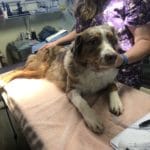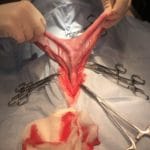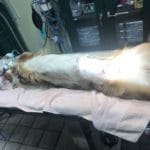hello,
I have to say that polyps (in my opinion) are less likely as cats age.
Next, I do believe there are still vets out there willing and able to sedate/anesthetize a cat and look for a polyp. Please call all the vets you can and reach out to every shelter and rescue for advice on who they use. If, and when you find someone please (please!!!) add their names via the storylines section above so it can help someone down the road. If we dont start sharing info we will continue to lose options and affordable care.
If all else fails I am happy to see your cat. call the clinic at 410-692-6171 and ask the receptionists to take your name and number. I cannot give advice over the phone, but I can arrange an appointment time for your cat to be seen so we can look for a polyp.
There is someone closer to you, I am sure, its just finding them. I am appalled at how ridiculous vet med has become. No one will even look for these anymore? Why? Honestly I dont know?
Please keep me posted and best of luck.
krista
Our 9 Year Old Border Collie the vet believes has Colon/Rectal Cancer. He did a rectal exam and can feel several large masses narrowing his colon. Our
dog started limping and favoring a back leg 2 weals ago, then 5 days ago has been unable to poop. Just little pieces of poop would come out, and he would
be trying to go for several minutes. The Vet believes the narrowing of the colon due to the masses inside are also pinching the nerves causing his limp, since
our dog did not injure his hind leg, and is not in pain.
He is referring us to a Vet that can image the area, and possibly due radiation.
Does anyone have and advice for us ??? Does anyone have and history to share with us???
We appreciate any feedback.
Comments
My Son’s cat Tom, is a rescue we have had approximately 12 years, putting his age about 13 to 13 1/2. Best cat I have ever had in my house! He thinks he is a member of the pack of 3 Jack Russells that run around here, and will not hesitate to stop one in it’s tracks to bathe them! For approximately the last 6 months he has developed a snoring noise, even when he is wide awake, and his local Vet says he has naso-pharyngeal polyps. Over the last month or so, he has had increasing difficulty swallowing his food. He has been on an Iams dry food for years and never had issues until no. We have switched to pulverizing the dry in a food processor and mixing it into some can foods he likes but he still eats very little at a time and always acts like he is starving. Having seen your videos of removing polyps from a cats throat area has led me to reaching out to you for help/advice. I certainly don’t want this cat to starve to death, and his discomfort is clear. Every local Vet I have contacted here in the Norfolk,Va. area has come back with estimates over $2000.00!!! I love this cat, but at 13 years old, I can’t do that and send my son to is first year of college. I am completely open to suggestions, and if need be, open to a 5 hour ride to see you.
Comments
Hi, my female torti Dusty has bumps on her tongue… The vet had me give her doxycycline liquid and prednisone for 2 months… the bumps didn’t change, but while I was there, she also told me to stop giving her wet food. About a week or so ago I stopped her wet food (which is Sheba Perfect portions) and just gave her the puro a one sensitive stomach hard food she has been eating for 2 years (I was doing 50/50)… I noticed she is having issues peeing… no pain, but she takes me to see she is only peeing about a teaspoon or so and she does it very often… she isn’t showing any signs of pain or lethargy, and eating fine. I tried to feel around but not sure if I found a bladder or not, nothing feels hard and she only complains as much as usual so I don’t think anything hurts.
I’ve watched videos on expressing a bladder and catheterizing a male, but I can’t seem to find any info on females (still looking)… my mom’s dog had 3 bladder stones for over a month just peeing a few drops every time and then all of a sudden they just popped out so I’m trying to weigh the cost-benefit with the local vet. Today is Sunday and I wasn’t about to go emergency if she wasn’t in pain, but I’m still afraid they’ll want $500+ to do anything since just a physical with no blood tests or shots is over $100 and I’m sure they’ll want xrays, etc. I’m in Florida and I know vets here charge 2x-3x more than other places.
Any info will help
Female
Indoor
Shorthair
About 10 yrs young
No signs of sick/injured/pain











Good morning- I’m sorry you have this going on. I think that comfort and quality have to play a role in any decision making. And budget. That is the reality of it. Talk with your vet. Talk with the specialist you are going to. Talk about all possible prognosis and all possible options. Be sure to voice your concerns- you may want to start keeping a written list so that you don’t forget anything at your visit. Very best to you. Please keep us posted-